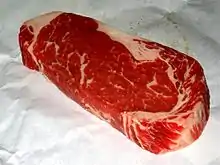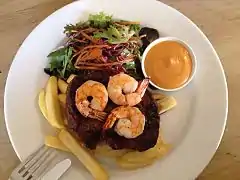Surf and turf
Surf and turf or surf 'n' turf is a main course combining seafood and red meat.[1][2] A typical seafood component would be lobster[3] (either lobster tail[4] or a whole lobster[5]), prawns, shrimp,[6] squid or scallops, any of which could be steamed, grilled or breaded and fried. The meat is typically beef steak, although others may be used. One standard combination is lobster tail and filet mignon.[3]
.JPG.webp) | |
| Main ingredients | Seafood and red meat |
|---|---|
| Part of a series on |
| Steak |
|---|
 |

Surf and turf is a regional cuisine eaten in steakhouses in the United States, Canada[4] UK and Australia, and may also be available in some British/Irish-style pubs in those countries.
Surf and turf is often considered as an example of conspicuous consumption and kitsch, as it combines two expensive foods which are not normally considered to be complementary:[7][8]
Surf 'n' turf is an example of the voracious rapture that defines much classic kitsch: adding two swanky things together in hopes of doubling their value, and in fact winding up with a flatulent faux pas.
...the point of surf 'n' turf is to maximize hedonistic extravagance...
This meal is stunt food. It exists because it's a way for restaurants to package the two most expensive items on the menu—tenderloin and lobster—into one ostentatious price tag. Otherwise, these two items don't even go together. It's the most conspicuous of conspicuous consumption, and maybe even a little cliché.
— Jared Stone, 2015[7]
Etymology
It is unclear where the term originated. The earliest known citation is from 1961, in the Los Angeles Times.[1]
History
In late 19th-century America, combining large portions of lobster and steak was popular at "show restaurants known as lobster palaces", favored by nouveau riche "arrivistes". This became unfashionable by the 1920s, and only regained popularity in the early 1960s.[8]
Surf 'n' turf was featured in 1962 at the Eye of the Needle, a revolving restaurant atop the Space Needle in Seattle, Washington.[8]
Surf and turf is often considered to symbolize the middle-class "Continental cuisine" of the 1960s and 1970s,[9] with (frozen) lobster and steak as replacement for the middle class.[10]
The name has been reappropriated by more recent chefs, such as Thomas Keller.[11]
Variations
A variation is the surf and turf burger, which is prepared with ground beef and various types of seafood, such as lobster, shrimp or crab.[12][13][14][6]
References
- "surf and turf, n.". Oxford English Dictionary, 3rd edition, March 2012, s.v. (subscription required)
- McGraw-Hill Dictionary of American Idioms and Phrasal Verbs, 2003, s.v.
- Ruhlman, Michael (2001). The Soul of a Chef. Penguin. pp. 184. ISBN 1101525312.
- Stern, J.; Stern, M. (2003). The Harry Caray's Restaurant Cookbook: The Official Home Plate of the Chicago Cubs. Thomas Nelson. p. PT 192. ISBN 978-1-4185-6826-9.
- Billings, C.; Bayer, B. (2014). The Maine Lobster Industry: A History of Culture, Conservation and Commerce. History Press. p. 65. ISBN 978-1-62619-410-6.
- Jackson, Kate Morgan (May 20, 2015). "A burger surf and turf". NorthJersey.com. Retrieved July 26, 2015.
- Jared Stone, Year of the Cow How 420 Pounds of Beef Built a Better Life for One American Family, 2015, ISBN 125005379X, p. 153
- "Surf 'n' Turf", in Jane Stern, Michael Stern, The Encyclopedia of Bad Taste, 1990, ISBN 0060164700, p. 279-280
- "Obama's Can't-Miss Banquet Menu", Restaurant Hospitality, January 24, 2011. : "Let’s see, surf and turf, glazed carrots, double-stuffed potatoes, apple pie — this meal seems to ignore every dietary and culinary trend of the last 30 years."
- George H. Lewis, "The Maine Lobster as regional icon: Competing images over time and social class", Food and Foodways: Explorations in the History and Culture of Human Nourishment 3:4 (1989) doi:10.1080/07409710.1989.9961958, reprinted in Barbara G. Shortridge and James R. Shortridge, eds., The Taste of American Place, p. 79. "As one moves downward in the American socioeconomic class structure, one sees lobster retain its image as a status foodstuff. To be affordable to the middle class, however, the actual lobster eaten usually takes the form of frozen Australian lobster tail, many times served along with steak as part of a standard middle-class status meal known as "surf and turf". Thus the image of rarity and status is retained, but a cheaper product that has no relationship to Maine ... is substituted for the authentic foodstuff."
- Michael Ruhlman, The Soul of a Chef: The Journey toward Perfection, 2000, ISBN 067089155X, passim: "When he began cooking, surf and turf ... was served at the best Continental restaurants, the apotheosis of class back then ... Surf and turf, then, can only be used ironically in light of what we now consider sophisticated food."
- Keller, H.; Wisner, P. (2015). Burger Bar: Build Your Own Ultimate Burgers. Houghton Mifflin Harcourt. p. 25. ISBN 978-0-544-79168-8. Retrieved July 23, 2017.
- Pilz, D. (2013). Grilling, Grilling & More Grilling. Charlesbridge Publishing. p. 79. ISBN 978-1-60734-661-6. Retrieved July 23, 2017.
- "Surf and turf burger at Morton's in Hackensack". North Jersey. May 11, 2017. Retrieved July 23, 2017.
External links
 Media related to Surf and turf at Wikimedia Commons
Media related to Surf and turf at Wikimedia Commons